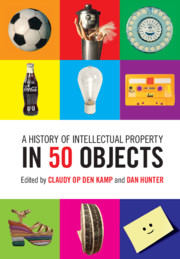Book contents
- Frontmatter
- Dedication
- Contents
- Acknowledgments
- Introduction: Of People, Places, and Parlance
- The Pre-Modern Period
- The Age of invention
- Modern Times
- The Consumption Age
- The Digital Now
- 39 Polymer Banknote
- 40 Post-it Note
- 41 Betamax
- 42 Escalator
- 43 3D Printer
- 44 CD
- 45 Internet
- 46 Wi-Fi Router
- 47 Viagra Pill
- 48 Qantas Skybed
- 49 Mike Tyson Tattoo
- 50 Bitcoin
- About The Contributors
41 - Betamax
from The Digital Now
Published online by Cambridge University Press: 12 June 2019
- Frontmatter
- Dedication
- Contents
- Acknowledgments
- Introduction: Of People, Places, and Parlance
- The Pre-Modern Period
- The Age of invention
- Modern Times
- The Consumption Age
- The Digital Now
- 39 Polymer Banknote
- 40 Post-it Note
- 41 Betamax
- 42 Escalator
- 43 3D Printer
- 44 CD
- 45 Internet
- 46 Wi-Fi Router
- 47 Viagra Pill
- 48 Qantas Skybed
- 49 Mike Tyson Tattoo
- 50 Bitcoin
- About The Contributors
Summary
THE SCENE IS middle-class suburbia, in the late 1970s. We are in a comfortable family living room, anywhere in North America, Europe, or Australia. The signs of postwar affluence: earthy colors, plush sofas, carpet, an elegant wooden Scandinavian coffee table, a stereo System complete with turntable and a collection of records. A television, of course, perhaps a 19-inch Sony Trinitron (then still under patent), with its distinctive cylindrical screen. The TV is not new, but next to it sits a striking indication that this domestic order is about to change: a Betamax videotape cassette recorder, a bulky electronic box, also produced by the Japanese company Sony. It is the first of its kind to find its way into middle-class households in large numbers.
A sense of promise and possibility resonates in this machine's low hum. It has a wood-grain finish, a blinking digital clock, a hatch on top for loading tapes, and a group of large control keys. A cable attaches the Betamax to the TV. A few paperback-sized plastic videotape cassettes sit beside it. On the sleek coffee table we find a remote control and a TV schedule. A thin wire connects the remote to the recorder. We can see at once that this new thing is part of an array of objects: the tapes, the remote, the device itself, and the connected television set are all elements in a video ecology. We're not sure at this stage what this array of things can or might do. Will we all now become video producers? Video librarians and curators? All sorts of imaginary video futures are attached to this object. We know now that some possibilities were realized, some not. But the video recorder changed entertainment for good. It had ramifications around the world for the screen industries, visual culture, for technology and intellectual property. Its effects remain with us today.
What did the Betamax mean for the owners and consumers of video content? And how did it become the center of a huge battle between its Japanese manufacturer and the Hollywood studios? In the famous 1984 case of Sony Corp of America v.
- Type
- Chapter
- Information
- A History of Intellectual Property in 50 Objects , pp. 336 - 343Publisher: Cambridge University PressPrint publication year: 2019

